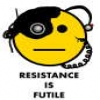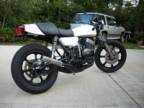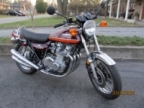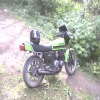- Posts: 650
- Thank you received: 1
Carb inner cleaning for rebuild
- Qdude
-
 Topic Author
Topic Author
- Offline
- User
- It is all good.
So what are we to do now?
If I am going to rebuild my carbs, how should I be sure that there is no residue in the inner workings.
How much should I expect to spend?
Is it best to have them professionally cleaned/tanked/????
What is a good alternative?
Any suggestions?
77 KZ 650 C1.
77 KZ 650 C1.
Crashed-Repaired, Pods, Kerker pipe, re-wired core bundle, lamp upgraded, homemade rectifier, solid state regulator , Dyna-s ignition, repainted, slightly modified, year-round commuter
Honda Metro 85 mpg Scooter. Dont laugh I will throw it at you
Please Log in or Create an account to join the conversation.
- TexasKZ
-

- Offline
- Platinum Member
- Posts: 7580
- Thank you received: 2237
1982 KZ1000 LTD parts donor
1981 KZ1000 LTD awaiting resurrection
2000 ZRX1100 not ridden enough
Please Log in or Create an account to join the conversation.
- TexasKZ
-

- Offline
- Platinum Member
- Posts: 7580
- Thank you received: 2237
1982 KZ1000 LTD parts donor
1981 KZ1000 LTD awaiting resurrection
2000 ZRX1100 not ridden enough
Please Log in or Create an account to join the conversation.
- Qdude
-
 Topic Author
Topic Author
- Offline
- User
- It is all good.
- Posts: 650
- Thank you received: 1
Both excellent threads.
Have you seen the "Arm and Hammer Soda medium sandblaster" that someone made out of an air compressor and 5$ worth of hardware?
I am trying to find the thread...
77 KZ 650 C1.
77 KZ 650 C1.
Crashed-Repaired, Pods, Kerker pipe, re-wired core bundle, lamp upgraded, homemade rectifier, solid state regulator , Dyna-s ignition, repainted, slightly modified, year-round commuter
Honda Metro 85 mpg Scooter. Dont laugh I will throw it at you
Please Log in or Create an account to join the conversation.
- Kawickrice
-

- Offline
- User
- After Monday & Tuesday, even the calendar says WTF
- Posts: 2496
- Thank you received: 18
Thank you Sir!!
Both excellent threads.
Have you seen the "Arm and Hammer Soda medium sandblaster" that someone made out of an air compressor and 5$ worth of hardware?
I am trying to find the thread...
That thread is under tools in the main forum menu
The Green way to do carbs is boil them in lemon juice. I have never tried it but there are a few threads on it and seems to have favorable reviews.
73 Kawasaki Z1
07 HD CVO Ultra Classic
82 Suzuki GS 1100
74 Yamaha RD 350 (My two stroke toy)
77 Kawasaki KZ 650B-1 (My putt around bike)
80 Indian Moped (My American Iron)
1
Long Gone
75 Suzuki GT550
74 GT 380
79 RD 400 Daytona Special
72 Honda CL 175
74 Honda QA 50
Tampa FL
Please Log in or Create an account to join the conversation.
- MFolks
-

- Offline
- User
- Posts: 6650
- Thank you received: 540
Carb Cleaning 101
By M. Shively
The elements of internal combustion engines are: correct fuel/air ratio, spark at right time, and adequate cylinder compression.
There are many passageways and openings to check and clean. All are important in function and when obstructed or not working properly, have subtle to radical effects on engine performance. Vacuum leaks and carburetor synchronization also effect performance and should be inspected and adjusted following the below procedures.
Warning: Remove all rubber parts before you begin. These parts usually include vacuum diaphragms, needle valves, o'rings, hoses, and other parts. Spray cleaners will damage these parts. Do not disassemble individual carbs from the carb bracket.
Air & Fuel Passageways: Trace and learn individual fuel and air circuits from beginning to end. Machines can only drill straight through the cast passageways. To change direction, another angled passageway must be drilled. The union is plugged with a brass or bronze bead. Inspect and clean each passageway with spray cleaner, brushes/pipe cleaners/etc, and compressed air. Remove any discoloration and debris. Look for spray cleaner to exit from one or more passageways.
Jet Cleaning: Inspect jets by holding to light and look through them. You should see an unobstructed round hole. Clean the jets with one or more of the following: jet cleaning wires, soak solutions, carb spray cleaners and compressed air. Re-inspect jets after cleaning and install when clear of obstructions. Some main jets have paper-like gaskets. Most have metal spacers between the jet and the emulsion tube. Some screw directly into a brass emulsion tube which is machined for a 7mm wrench at its float chamber exposed base.
Inlet Fuel Valve: Inspect the needle valve & spring. Press down the tiny metal rod that protrudes from the butt or float end of the needle valve. The spring should move freely and return the rod to its location. Check the needle valve's seat area for a groove or other wear. It should appear highly polished. Some needle valve seats are rubber and wear may not be visible. Inspect the needle valve jet seat. You can clean the jet seat with Q-tips and semi-chrome polish if necessary.
Carb Body Castings: Blow air through the atmospheric vent holes located on the dome of each float bowl chamber. Air should exit via hoses or brass nipples. Inspect the emulsion tubes and passageways (cast towers that jets thread into) for discoloration and debris. Clean interior emulsion towers with a soft bristle gun cleaning brush. Clean each Venturi (main carb bore).
Needle Jets & Jet Needles: Clean the needle jets, jet needles, and passageway or tower that needle jet screws into. Clean the emulsion tube (pipe between needle jet and main jet) (Main Jet may screw into emulsion tube). Jet needles are part of the throttle slides. See below…
Throttle Slides: There are several types of throttle slides: Mechanical linkage, vacuum, diaphragm, and cable. Disassembling the jet needle from the slide is not always required for cleaning. If you have vacuum piston type throttle slides (large diameter solid metal slide), avoid cleaning the lubrication from sides and caps. If piston type check cap vents and passageways with air. Clean if necessary and re-lube. If you have rubber vacuum throttle diaphragms, inspect for dry-rot, defects, and tears by gently stretching rubber away from center. Do this until all areas around diaphragm have been inspected. Replace any defective part as described above. Clean carb body areas around diaphragm including air passageways and air jets. Diaphragms have a locator loop or tab fabricated into their sealing edge. Observe this locator upon reassembly. Avoid pinching the diaphragm when reinstalling caps.
Fuel Screws: Fuel screws have sharp tapered ends. Carefully turn one fuel screw in while counting the turns until it seats lightly. Warning: These screws are very easily damaged if over tightened into their seats. Record amount of "turns-in" and remove the fuel screw, spring, washer, and o'ring. The fuel screw is part of the enrichment (choke) circuit...clean passageways as described above. When carbs are assembled, spray low PSI compressed air into diaphragm air vents located at intake side of carbs. Throttle slides should rise, then fall when air is removed. Lightly lube external moving linkages. Reinstall carbs and follow through with carburetor synchronization.
Throttle Cables: Lubricate cables periodically. If cables are disconnected from carbs or removed for replacement, etc . . . remember cable routing and ensure proper reinstallation routing. Avoid bread-tying, sharp bends, and pinching cables. Adjust cables so throttle grip has about 5mm of play or throttle slides or butterfly valves may not open completely (full throttle)(wide full open).
Float Bowls: Inspect float bowls for sediment, gum or varnish, crystallization, and defects. Clean all pipes, tubes, passageways, and embedded jets with cleaners and compressed air. Remove and clean the drain screw and area. Inspect bowl gasket and replace if necessary. Clean and inspect overflow pipes and tubes, look for vertical cracks.
Floats: There are several types of float materials: plastic, brass, black composite, tin, and others. Handle floats carefully. Avoid bending, twisting, denting, or other means of mishandling. Most floats are adjustable by bending a small metal tab near the float axle end. Do not change the float adjuster tab unless tuning fuel service levels. Clean metal floats by soaking or by spraying cleaner and wiping clean. Other material type floats may require replacement if cleaning is necessary. Inspect the needle valve (float valve) and seat. Check needle valve's spring loaded pin. It should depress and return smoothly and without resistance. Check the needle valve's tip for a worn groove. Replace needle valve and seat if either symptom exists. These parts wear together and must be replaced as a set.
Synchronization: This is a fine adjustment performed usually and preferably with the carbs installed and the engine running. The unusual part is performed with gauged wire with the carbs on the work bench. Carburetor synchronizing balances Venturi vacuum at the exhaust side of each carburetor, resulting with smooth idling and optimized performance at all throttle openings. Synchronization is checked using a set of gauges which are either air vacuum type or liquid mercury type. The gauges are connected to vacuum ports on the intake manifolds via nipple tubes or if sealed with screws, sync gauge adapters will be needed. With the engine running at temperature, and with a fan or means of forced convection aimed onto the engine, the carbs fuel screws and idle are adjusted, then the synchronization is adjusted via adjustment screws on the carbs. A reserve fuel tank is recommended for convenience of accessing carbs during this procedure. See gauge instructions and repair manuals for detailed use of synchronization gauges.
Notes: While carbs are apart, record the jet sizes. Look for a very small number imprinted on the body of the jets. Verify that numbers are the same for all jets on models with in-line cylinders. A few transverse-4 models and V-engines, the inner and outer carbs use some different size jets and it's important to not mix them up. If you have dial or veneer calipers, measure and record float heights. Perform measurements with floats just touching needle valves, though not depressing the needle valve rods. Replace fuel and vacuum hoses. Be sure to use fuel rated hose for fuel. Install or replace in-line fuel filters. It's a good time to remove and clean interior petcock fuel filters. Inspect carb manifolds for dry-rotting, inspect all clamps and air ducts. Inspect, clean, lube, and/or replace air filter(s).
And this:
Lemon Juice Carb Cleaning(Found on the internet)
If it was me, I'd pull the top covers off, pull the slides out, drop off the bottom bowls, remove pilots/mains. Then with the rest of the carbs still assembled boil them in some lemon juice. You'll need a big roaster pan, a little over a gallon of lemon juice (cooking supply stores), and an understanding wife/girlfriend cause the sh*ts gonna stink a little.
Boil them for about 15 minutes, then rinse them really well and blow them dry with compressed air (make sure all passages are clean). You'll be amazed at how clean they come in that short of a time.
I just did a set yesterday after hearing about it from a buddy who's used lemon juice on a couple dozen racks of carbs. After a couple of minutes at slow boil the lemon juice starts to foam up a little (careful not to boil over) and you can see all the sh*t just dissolving.
After boiling them for 15 minutes (might have to roll them around once to make sure you get the entire carbs) rinse them really well and blow them dry with compressed air. The carb bodies will be kinda chalky looking at this point. I used a toothbrush and PB blaster to put a little luster back into them and then put my internals back in.
I had pulled the bowls off, removed the floats, float needles and seats, jets, and air/pilot screws as well as the top covers and slides just to make sure no crap got itself wedged inside those passages.
After putting the carbs back together and bolting them up not only do they look great but the bikes running MUCH better with all the jet passages finally cleaned out.
1982 GPZ1100 B2
General Dynamics/Convair 1983-1993
GLCM BGM-109 Tomahawk, AGM-129A Advanced Cruise Missile (ACM)
Please Log in or Create an account to join the conversation.
- TeK9iNe
-

- Offline
- User
- What did you do!?!
- Posts: 2440
- Thank you received: 28
Motorcycle Shop Owner/Operator
79 Kawie Z1000 LTD
81 Kawie Z1000 CSR
83 Honda VT750C A
85 Kawie GPZ900 A2
86 Zukie GS1150 EG
93 Yamie XV1100 E
Lucky to have rolled many old bikes through my doors
Please Log in or Create an account to join the conversation.
- Kawboy74
-

- Offline
- User
- Posts: 319
- Thank you received: 52
1974 Z1A As original as I could get it
'88 ZX750R braided lines, mostly original
KZ1000 project on the bench
Burlington,Ontario,Canada
Please Log in or Create an account to join the conversation.
- Qdude
-
 Topic Author
Topic Author
- Offline
- User
- It is all good.
- Posts: 650
- Thank you received: 1
Heated acid, earth friendly, lemoney scent?
That is better than getting kicked in the balls.
77 KZ 650 C1.
77 KZ 650 C1.
Crashed-Repaired, Pods, Kerker pipe, re-wired core bundle, lamp upgraded, homemade rectifier, solid state regulator , Dyna-s ignition, repainted, slightly modified, year-round commuter
Honda Metro 85 mpg Scooter. Dont laugh I will throw it at you
Please Log in or Create an account to join the conversation.
- 550A2
-

- Offline
- User
- keep the shiny side up
- Posts: 428
- Thank you received: 1
after that blow em out and cruise!
82 Honda ATC 200-sold
82 Yamaha Virago 920-sold
82 Yamaha YZ250j-kept
80 Suzuki GS 550-sold
82 Kawasaki KZ550 A2-ride all the time
79 Kawasaki KZ650 C-sold
73 Kawasaki Z1 900E-paid $200, sold $6000
86 Yamaha Radian YX600-new project
Please Log in or Create an account to join the conversation.
- bluej58
-

- Offline
- Sustaining Member
- The chrome don't get you home
- Posts: 2484
- Thank you received: 511
78 KZ1000 A2A
Please Log in or Create an account to join the conversation.
- MFolks
-

- Offline
- User
- Posts: 6650
- Thank you received: 540
1982 GPZ1100 B2
General Dynamics/Convair 1983-1993
GLCM BGM-109 Tomahawk, AGM-129A Advanced Cruise Missile (ACM)
Please Log in or Create an account to join the conversation.
